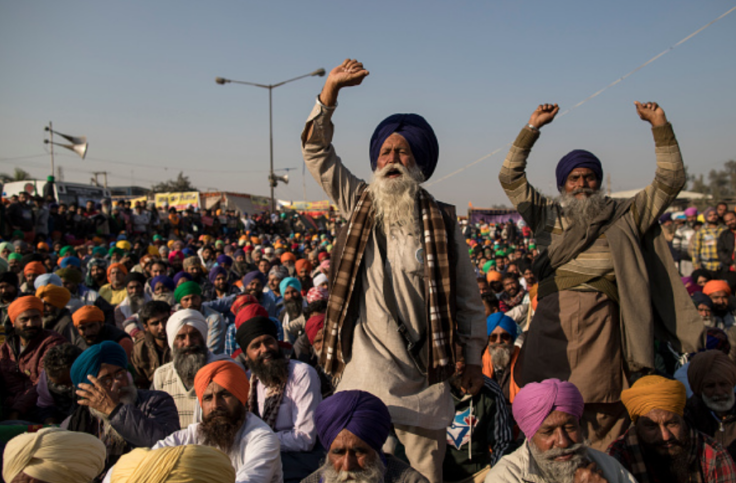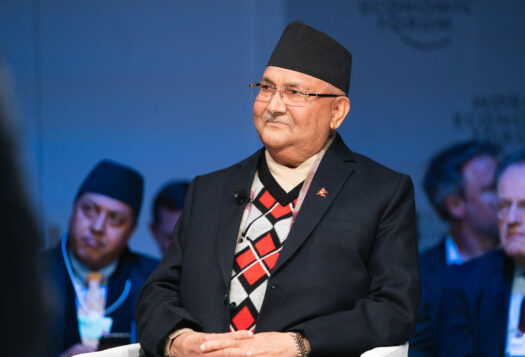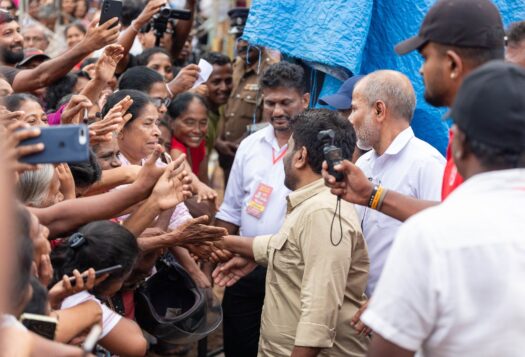
India’s farmers are on the warpath again, just a few weeks before the country’s general elections. More than 20,000 farmers, riding on tractors and trucks, have been trying to head toward New Delhi since February 13, in an attempt to pressure Prime Minister Narendra Modi’s government into meeting their demand for guaranteed minimum support prices for crops. The farmers tried to push through multi-layered barricades of concrete blocks, barbed wire, and spikes erected by the police. Security forces stopped them by dropping tear gas shells from drones and firing rubber bullets. Farmers are camping at two locations, about 200 kilometers away from Delhi, with bulldozers, hydraulic cranes, and thousands of tractor trolleys loaded with dry rations and water-proof sheets. Four rounds of talks between the government and representatives of the farmers have failed. The protests have intensified after a farmer died following clashes with police.
In India, farmers’ demands are ambitious and complex. Here’s why.
Who Are the Protesting Farmers?
About 200 farmers’ unions from the northern state of Punjab, known as India’s grain bowl, are spearheading the agitation, along with cultivators from neighboring Haryana and Uttar Pradesh. The 1960s Green Revolution – which made the country self-sufficient in food for the first time – took off from Punjab.
Punjab farmers extensively used free electricity and subsidized fertilizer to produce water-guzzling crops such as wheat and rice because of assured state purchases. They later became reluctant to cultivate less water-consuming crops. Their incomes gradually declined with the rising cost of production, decreasing yields, and wild fluctuation in market prices. Now they are fighting for better incomes from agriculture. Farmers from southern regions have not joined the protests because of differing aspirations.
Indian farmers launched nationwide, powerful protests in 2020-21 against new controversial farm laws that the government said aimed at easing rules around the sale, pricing, and storage of farm crops. The yearlong protest ended after Modi backtracked and promised to repeal the laws. The government formed a panel to consider guaranteed crop prices across the country. Now the farmers are back on the road to Delhi, claiming the government has not upheld its promises.
About 65 percent of the country’s population lives in rural areas and 47 percent of Indians are dependent on agriculture for their livelihood. But their growth has consistently lagged, even as India became the world’s fastest-growing major economy.
What Are Their Demands?
The farmers are seeking guarantees, backed by law, for minimum support prices for 23 crops, whose floor prices should be fixed at 50 percent above the comprehensive cost of production. The cost formula was recommended by the late scientist M. S. Swaminathan, widely known as the father of India’s Green Revolution.
Although the government sets minimum floor prices for 22 crops – based on normal production costs, market trends, and demand-supply conditions – it mainly buys wheat and rice at predetermined prices from farmers for its welfare programs. The guaranteed prices are used as benchmarks for various farm commodities, but private buyers aren’t legally obligated to pay that amount to farmers. Besides legally guaranteeing support prices, the farmers are also demanding pensions, waivers on farm loans, and compensation for more than 700 farmers who died during the 2020-2021 protests.
What Is the Root Problem?
About 65 percent of the country’s population lives in rural areas and 47 percent of Indians are dependent on agriculture for their livelihood. But their growth has consistently lagged, even as India became the world’s fastest-growing major economy.
The average monthly income for agricultural households was about 10,000 rupees (USD $120) a month in 2019 and about half of the families were in debt. About half of the country’s farmers lack access to traditional financing sources. The declining public spending on farming in the past decade and the lack of reforms have contributed to the dismal performance of the agriculture sector, which employs close to half of India’s workforce but generates less than a fifth of the country’s gross domestic product. Modi had promised a doubling of farmers’ income by 2022. But the promise remains unfulfilled.
Why the MSP Regime Doesn’t Help Farmers
The reach of the MSP regime as currently implemented is very limited. While the support prices are announced for about two dozen crops, it works mostly for rice and wheat mainly because India has vast storage facilities for these grains and uses the produce for its public distribution system. The government has announced it will provide 5 kilograms of free food grains for 810 million poor until 2028.
Procurement of grains from farmers is also not sufficient. About 49 percent of the rice production was procured in the year to March 2021 by the government while the figure for wheat was 40 percent, according to PRS Legislative Research. Again, the system is unfair for those farmers who grow millets, oilseeds, fruits, and vegetables. Only 2 percent of coarse production was procured during that period. Thus the support price system, introduced in the 1960s to help India maintain food security, only gives benefits to a minuscule number of farmers.

Why the MSP Remains a Sticky Issue
This is the most controversial issue. Those who are in favor argue that the MSP will make farmers’ income more secure, help reduce rural economic distress, and encourage crop diversification – a change required to check declining water levels. Those who oppose it say that it will make the market less flexible, lead to a rise in food inflation and an overproduction of crops, and bring fiscal disaster. Additionally, it could impact agricultural exports and global competitiveness. “Legal guarantee of MSP will not help farmers move out of agriculture into other more productive sectors,’’ such as manufacturing and services, which is required for the country to attain its full potential, Neeraj Kaushal, professor of social policy at the Columbia University, told The Diplomat.
Instead, “it would be a fiscal disaster and have inflationary consequences,” if farmers’ demands are met. There is no clear consensus on whether a legally guaranteed MSP would be inflationary. Ashok Gulati, a distinguished professor at Indian Council for Research on International Economic Relations, told The Wire that food prices would increase by 25 to 30 percent. To counter this, Vikas Rawal, professor at the Jawaharlal Nehru University, said that if the increasing cost of cultivation can be contained, the MSP will cease to be inflationary.
Similarly, the cost for MSP implementation for all crops is also debatable. It’s not easy to estimate as the cost depends upon various factors such as prevailing market prices, quantity of procurement by the government, and duration. CRISIL Market Intelligence & Analytics estimates it will only cost 210 billion rupees (USD $2.53 billion), while some other analysts predict it will cost 10 trillion rupees (USD $120 billion) per year.
Modi’s Bharatiya Janata Party is likely to emerge unscathed electorally, said Asim Ali, a New Delhi-based independent political analyst, arguing that farmers unions are not united, with some abstaining from the current protest.
What Is the Way Forward?
Providing direct income support tied with investment in farmland is a better solution to support farmers, said Poornima Varma, an assistant professor at the Indian Institute of Management in Ahmedabad. Varma added that the current procurement process, which is practically limited to few food grains and states, should be revamped to make it effective. Some experts argue that farmers can also be supported through a price stabilization fund, so that when market prices fall below the MSP levels, the government makes up the difference. Augmentation of farm incomes through diversification to high value agricultural produce such as fruits, vegetables, and more farming of livestock is another idea.
What Are the Political Ramifications?
Farmers don’t always vote as one bloc but enjoy sizable influence in the countryside, where most Indians live. Hence the government tries to avoid any major confrontation with them. This farmers protest comes just a few weeks ahead of elections, which Modi is widely expected to win comfortably to secure a third successive term in power. Meanwhile, the main opposition Congress party has promised legal guarantees for the MSP in order to win farmers’ support.
Modi’s Bharatiya Janata Party is likely to emerge unscathed electorally, said Asim Ali, a New Delhi-based independent political analyst, arguing that farmers unions are not united, with some abstaining from the current protest. The ruling party has forged alliances with some parties that enjoy wider support from farmers.
Still the ruling party will try to pacify farmers’ simmering resentment before the polls open.
Editor’s Note: A version of this piece originally appeared on The Diplomat and has been republished with permission from the editors.
Also Read: Elevating India’s Agricultural Diplomacy for Global Food Security
***
Image 1: Anindito Mukherjee via Getty Images


